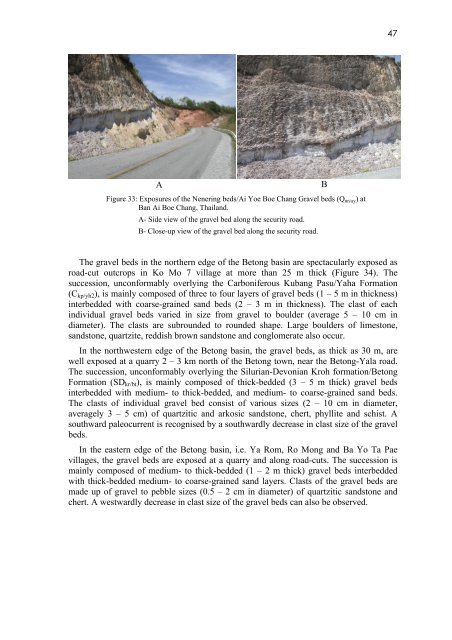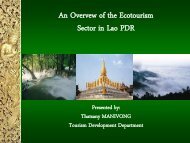GEOLOGY OF THE PENGKALAN HULU-BETONG TRANSECT ...
GEOLOGY OF THE PENGKALAN HULU-BETONG TRANSECT ...
GEOLOGY OF THE PENGKALAN HULU-BETONG TRANSECT ...
You also want an ePaper? Increase the reach of your titles
YUMPU automatically turns print PDFs into web optimized ePapers that Google loves.
A B<br />
Figure 33: Exposures of the Nenering beds/Ai Yoe Boe Chang Gravel beds (Qnn/ay) at<br />
Ban Ai Boe Chang, Thailand.<br />
A- Side view of the gravel bed along the security road.<br />
B- Close-up view of the gravel bed along the security road.<br />
The gravel beds in the northern edge of the Betong basin are spectacularly exposed as<br />
road-cut outcrops in Ko Mo 7 village at more than 25 m thick (Figure 34). The<br />
succession, unconformably overlying the Carboniferous Kubang Pasu/Yaha Formation<br />
(Ckp/yh2), is mainly composed of three to four layers of gravel beds (1 – 5 m in thickness)<br />
interbedded with coarse-grained sand beds (2 – 3 m in thickness). The clast of each<br />
individual gravel beds varied in size from gravel to boulder (average 5 – 10 cm in<br />
diameter). The clasts are subrounded to rounded shape. Large boulders of limestone,<br />
sandstone, quartzite, reddish brown sandstone and conglomerate also occur.<br />
In the northwestern edge of the Betong basin, the gravel beds, as thick as 30 m, are<br />
well exposed at a quarry 2 – 3 km north of the Betong town, near the Betong-Yala road.<br />
The succession, unconformably overlying the Silurian-Devonian Kroh formation/Betong<br />
Formation (SDkr/bt), is mainly composed of thick-bedded (3 – 5 m thick) gravel beds<br />
interbedded with medium- to thick-bedded, and medium- to coarse-grained sand beds.<br />
The clasts of individual gravel bed consist of various sizes (2 – 10 cm in diameter,<br />
averagely 3 – 5 cm) of quartzitic and arkosic sandstone, chert, phyllite and schist. A<br />
southward paleocurrent is recognised by a southwardly decrease in clast size of the gravel<br />
beds.<br />
In the eastern edge of the Betong basin, i.e. Ya Rom, Ro Mong and Ba Yo Ta Pae<br />
villages, the gravel beds are exposed at a quarry and along road-cuts. The succession is<br />
mainly composed of medium- to thick-bedded (1 – 2 m thick) gravel beds interbedded<br />
with thick-bedded medium- to coarse-grained sand layers. Clasts of the gravel beds are<br />
made up of gravel to pebble sizes (0.5 – 2 cm in diameter) of quartzitic sandstone and<br />
chert. A westwardly decrease in clast size of the gravel beds can also be observed.<br />
47



